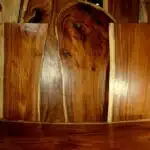Wood slats on a wall can add warmth, texture, and interest to any room. Installing wood slats is a straightforward process that can be completed in a weekend with the right tools and materials. In this article, we will go over the steps needed to install wood slats on a wall, from planning the layout to hanging the slats.
Before starting the installation process, it’s important to consider the type of wood you want to use and how you want to arrange the slats on your wall. You may choose between softwoods like pine or hardwoods like oak or maple depending on your preference. Additionally, you may opt for horizontal or vertical placement of your slats. Planning is key in achieving a cohesive and visually pleasing result. With careful planning and execution, installing wood slats can be an enjoyable project that transforms any space into a cozy haven.
Gather Necessary Tools And Materials
Did you know that wood slats have been used as a wall covering for centuries? In fact, this trend has become increasingly popular in recent times due to its rustic appeal. Installing wood slats on your wall is a cost-effective way to enhance the aesthetic appeal of your home. Before starting, it is essential to gather all the necessary tools and materials.
Choosing materials requires careful consideration. The type of wood you choose will determine the durability and longevity of your wall covering. Pine, cedar, and redwood are commonly used for their natural resistance to decay, but they are more expensive than other types of wood. You should also consider the thickness of the slats; thicker slats will provide better insulation and soundproofing. Safety precautions must be taken when working with power tools and sharp objects such as nails or screws.
To install wood slats on your wall, you will need a few basic tools and materials such as a drill or nail gun, level, measuring tape, saws, sandpaper, and safety gear like goggles and gloves. It is important to ensure that you have all necessary equipment before beginning the project to avoid interruptions during installation.
Now that you have gathered all the necessary tools and materials for installing wood slats on your wall let’s move on to measuring your wall space to determine how many slats you’ll need.
Measure Your Wall Space
Wall measurement is the first step in determining the amount of wood slats you need for your wall installation. It is crucial to measure your wall space correctly, as this will determine how much material you need to purchase. Use a tape measure to determine the height and width of your wall. Make sure to take accurate measurements by measuring twice and marking the measurements on a piece of paper.
Once you have measured your wall, it’s time to consider slat spacing. Slat spacing refers to the distance between each wood slat that will be installed on the wall. The spacing between each slat can have a significant impact on the overall look of your installation. Depending on the design you want to achieve, there are various options when it comes to slat spacing. Consider narrow or wide spaces between each slat, depending on what appeals most to you.
After considering slat spacing, it’s essential to create a plan for installation based on these measurements and considerations. This plan should include how many wood slats are needed based on their width and length, as well as their placement and distance from one another. Once this is determined, you can purchase all necessary materials and move onto determining where each wood slate will be placed along with any additional planning details before beginning actual installation work.
With these steps completed accurately, we can now move onto determining where each wood slate will be placed along with any additional planning details before beginning actual installation work.
Determine Slats Placement
After measuring your wall space, the next step is to determine the slat placement. One question that may arise is how much spacing is needed between each slat? The answer depends on personal preference and the overall look you are trying to achieve. However, a general rule of thumb is to leave a gap of around 1/4 inch to 1/2 inch between each slat. This will allow for wood expansion and contraction due to temperature changes.
Another factor to consider when determining slat placement is the texture of your wall. If your wall has a smooth texture, you can place the slats closer together without worrying about gaps. However, if your wall has an uneven texture, leaving slightly larger gaps between each slat can help disguise any imperfections in the wall surface.
To further aid in determining slat placement, it may be helpful to create a table or chart outlining the measurements of your wall and where each slat should be placed. Below is an example of such a table:
| Slat Number | Distance from Left Edge (inches) | Distance from Top Edge (inches) |
|---|---|---|
| 1 | 2 | 2 |
| 2 | 7 | 2 |
| 3 | 12 | 2 |
| … | … | … |
This table can be adjusted based on your specific measurements and desired spacing between each slat. Once you have created this table and determined the placement for each slat, mark guidelines on your wall accordingly before moving onto the next step.
Marking guidelines for placement will ensure that your wood slats are installed evenly and accurately. In the next section, we will discuss how to properly install these wood slats onto your marked guidelines without causing damage to your walls or creating any unnecessary gaps between them.
Mark Guidelines For Placement
Before installing wood slats on a wall, it’s important to mark guidelines for placement. This step ensures that the slats are evenly spaced and aligned with each other. There are various spacing options to choose from, depending on your personal preference and the size of the slats.
One marking technique is to use a chalk line. Start by measuring the width of your wood slats and dividing it by your desired spacing. Then, snap a chalk line along the length of the wall at each interval. Another option is to use a level and pencil to mark spots on the wall where each slat will be installed.
To make sure your wood slats are straight and aligned, it’s important to take accurate measurements and mark guidelines precisely. Here are some tips for marking guidelines:
- Use a level or straight edge for accuracy
- Measure twice before making any marks
- Make small marks instead of large ones that could be confusing later on
- Double-check your work before proceeding
By following these marking techniques, you can ensure that your wood slats will be installed accurately and look great on your wall. Next up, we’ll discuss how to prepare your wood slats for installation.
Prepare Your Wood Slats
Before installing your wood slats, it’s essential to prepare them properly. To start, you’ll need to choose the right sandpaper option for your project. Sanding is important because it smooths out any rough edges and creates a clean surface for your sealant or finish. There are various grades of sandpaper available, ranging from coarse to fine. Depending on the condition of your wood slats and their intended use, you may need to use more than one type of sandpaper to achieve the desired result.
After sanding your wood slats, it’s crucial to apply a sealant or finish to protect them from moisture and other types of damage. There are several types of sealants available on the market, including oil-based and water-based options. Oil-based sealants are often preferred for their durability and resistance to wear and tear. On the other hand, water-based sealants dry faster and emit fewer fumes than oil-based ones. The type of sealant you choose will depend on your personal preferences and the intended use of your wood slats.
Once you’ve selected your sandpaper options and sealant type, it’s time to get started with prepping your wood slats for installation! Sand down each piece until they’re smooth with no rough edges or splinters. Then apply a coat of sealant or finish that suits your needs best by using a paintbrush or roller. Allow the sealer or finish to dry completely before moving on to the next step: cutting your slats to size.
Cut Your Slats To Size
As the saying goes, measure twice, cut once. This is especially true when it comes to cutting your slats to size for installation on a wall. Before beginning this step, ensure that you have measured the width of the wall and calculated how many slats will be needed.
Once you have determined the required number of slats, it’s time to get out your cutting tools. Depending on the type of wood you are using and its thickness, you may need a saw or other specialized tool. It is important to use a sharp blade and take caution when cutting to ensure a straight edge.
When cutting your slats, it’s important to keep their width consistent throughout. This will provide an even appearance once they are installed on the wall. Take your time with each cut and double-check measurements before proceeding. With careful attention and precision, your slats will be ready for sanding in no time.
Sand Your Slats
When selecting the proper sandpaper for sanding wood slats, it is important to consider the type of wood, the desired finish, and the grade of the sandpaper. Sanding wood slats is a process that should be done slowly and carefully to ensure a consistent, even surface. Start with a coarse grade of sandpaper, working your way up to a fine grade for a smooth finish. Once the slats have been fully sanded, they can be installed on the wall.
Select Sandpaper
To achieve a smooth finish on your wood slats, it is crucial to choose the right sandpaper grit. Choosing grit can be confusing, but it’s crucial to get it right. The grit refers to the coarseness of the abrasive particles on the sandpaper. The higher the number, the finer the grit. For example, 220-grit sandpaper is finer than 120-grit sandpaper.
Different types of wood require different grits of sandpaper. Softwoods like pine and cedar require a lower grit between 80-120, while hardwoods like oak and maple require a higher grit between 150-220. It’s essential to start with a coarser grit before moving on to a finer one as it helps remove any rough spots or bumps on the surface of the wood slats.
In conclusion, selecting the right type of sandpaper is critical for achieving a smooth finish when installing wood slats on your wall. By choosing the appropriate grit based on your wood type, you can ensure that your walls look top-notch and professional when you’re finished with installation. Remember that different types of woods require different levels of coarseness in their sandpapers – so make sure to select carefully!
Sand Slats
When it comes to installing wood slats on your wall, sanding is an essential step in achieving a professional and polished look. Sanding not only smooths out any rough spots or bumps on the surface of the wood but also helps prepare the slats for staining or painting. To sand your slats efficiently, you’ll need to choose the right type of sandpaper and use proper techniques.
There are various types of sandpaper available, each with its own level of coarseness. The most common types of sandpaper include aluminum oxide, garnet, silicon carbide, and ceramic. Aluminum oxide is ideal for general-purpose sanding, while garnet is suitable for finishing work. Silicon carbide works well for wet sanding and polishing applications, while ceramic is ideal for heavy-duty sanding projects. By selecting the appropriate type of sandpaper based on your project’s needs, you can ensure optimal results.
Techniques for sanding your slats include using a back-and-forth motion along the grain of the wood to avoid damaging it. Start with a coarser grit (between 80-120) to remove any rough spots or bumps before moving onto finer grits (between 150-220) to achieve a smooth finish. Make sure to wipe away any dust or debris between grit changes and use consistent pressure throughout the process. With proper technique and the right type of sandpaper, you’ll be able to create a beautiful finished product that will enhance the overall look of your space.
Stain Or Paint Your Slats (Optional)
Stain or Paint Your Slats (Optional)
Once you have installed your wood slats, you may want to consider staining or painting them to add some color and character to your wall. There are pros and cons to each option, so it’s important to weigh them carefully before making a decision.
If you choose to stain your slats, you’ll be able to showcase the natural beauty of the wood grain. Staining also tends to be more durable than paint, as it seeps into the wood fibers rather than just sitting on top of them. However, there are fewer color choices when it comes to stains, so if you’re looking for something bold and vibrant, paint may be a better choice.
On the other hand, painting your slats will give you unlimited color options. You can choose any hue that matches your decor or personal style. Paint also allows you to cover up any imperfections in the wood. However, paint is more prone to chipping and peeling over time.
With these factors in mind, take some time to decide whether staining or painting your slats is right for you. Once you’ve made your choice, follow the appropriate steps carefully for best results. Next up, we’ll show you how to install your first slats on the wall.
Install Your First Slats
After completing the staining or painting process, it’s time to start installing your wood slats on the wall. The first step is to determine the spacing options you want to use. You can choose to have your slats spaced evenly apart or staggered for a more unique look.
Once you’ve decided on your spacing options, it’s time to install your first slat. Starting at the top of the wall, position your first slat and use a level to ensure it’s straight. Then, using a nail gun or drill, attach the slat to the wall with screws or nails. Repeat this process for each subsequent slat, making sure they are evenly spaced and level.
When all of your slats have been installed, it’s time to apply finishing techniques. Depending on whether you stained or painted your slats, you may need to add a protective coating such as polyurethane or clear coat. This will help protect your wood from damage and give it a polished look. Once finished, step back and admire your newly installed wood slats on the wall! Continue installing your slats until you’ve covered the entire surface area of the wall for a beautiful and unique accent feature in any room of your home.
Continue Installing Your Slats
Once you have started installing your wood slats on the wall, it is important to continue the process with care and precision. There are a few spacing options to consider when continuing the installation process. You can choose between a tight fit or leaving small gaps between each slat. Both options can provide unique aesthetic appeal and should be chosen based on your personal preference.
Another factor to consider when continuing with the installation process is alternative installation methods. While nailing the slats directly into the wall is a common method, there are other ways to secure them in place such as using adhesive or brackets. It is important to research and choose the best method for your specific project needs.
To further enhance the visual appeal of your wood slat wall, you can incorporate design elements such as alternating slat sizes or colors. This can add depth and texture to your installation and make it stand out as a unique feature in any room of your home. With these considerations in mind, you can confidently continue installing your wood slats on the wall.
As you near completion of your wood slat wall, cut and install end pieces for a polished finish. This step involves careful measuring and cutting of each individual piece to ensure a precise fit. Use appropriate tools such as a saw or miter box for accurate cuts. Once cut, install each piece securely using nails or adhesive depending on your chosen installation method. By following these steps, you can expertly complete your wood slat wall project with professional-looking results.
Cut And Install End Pieces
Cutting and installing end pieces for your wood slats is the next step in creating a stunning feature wall. The end piece design you choose can make a big impact on how the finished product looks, so it’s important to take your time and choose wisely. One popular option is to cut the ends of each slat at a 45-degree angle, creating a clean and modern look that will make your wall stand out.
When cutting your end pieces, it’s important to use a saw that is appropriate for the type of wood you are using. A miter saw or table saw will work well for most types of wood, but if you are working with particularly hard or dense wood, you may need to use a more heavy-duty saw. Additionally, if you want to experiment with alternative materials for your end pieces, such as metal or plastic, be sure to do some research beforehand and make sure they are compatible with the type of wood you are using.
Once you have cut all of your end pieces and ensured they fit perfectly against your starting and ending walls, it’s time to install them onto the slats themselves. This can be done using either nails or adhesive depending on personal preference and the weight of the slats. Regardless of which method you choose, be sure to take care when installing so as not to damage any surrounding slats or walls. With this step complete, all that’s left is filling any nail holes with putty and sanding down any rough edges before moving onto the next stage in creating your beautiful wooden feature wall.
Fill Nail Holes And Sand
After installing wood slats on a wall, the next step is to fill nail holes and sand the surface. This process will help you achieve a smooth and flawless finish that complements your home décor. To begin, use a putty knife to apply wood filler into each nail hole. Make sure to press the filler firmly into the hole and scrape off any excess to create an even surface.
Once you have filled all the nail holes, allow the filler to dry completely. Depending on the type of filler you are using, this process may take anywhere from 30 minutes to several hours. Once it’s dry, use fine-grit sandpaper to gently sand over the filled areas until they are flush with the surrounding wood slats. Be careful not to oversand or damage surrounding areas.
Alternative techniques for filling nail holes include using wax sticks or colored putty that matches your wood stain. These options can be quicker and easier than traditional wood filler methods but may not provide as seamless of a finish. Additionally, once you have completed filling and sanding, there are various decorating options available such as adding trim pieces or painting/staining the wall.
To further enhance your finished project, consider applying a finish coat (optional). This final step will protect your wall from scratches, scuffs, and other common wear-and-tear issues while also highlighting its natural beauty. There are multiple finish coat options available such as varnish or polyurethane that can be applied with a brush or roller depending on personal preference. With these simple steps, you will have successfully installed beautiful wood slats on your wall!
Apply A Finish Coat (Optional)
To apply a finish coat to your wood slats, you have a variety of options available. The first decision to make is whether or not you want to apply a finish at all. While some people prefer the natural look of unfinished wood, others may wish to apply a stain, paint, or clear coat for added protection and visual appeal.
If you do decide to apply a finish, there are pros and cons to each type. Stains bring out the natural beauty of the wood grain while protecting it from sun damage and weathering. Paints offer an endless array of color options but may obscure the texture of the wood. Clear coats protect the wood without altering its appearance but may require more maintenance in the long run.
Some of the best finishes for wood slats include polyurethane, varnish, and wax. Polyurethane provides a durable protective coating that resists scratches and stains. Varnish offers similar protection with a glossy finish that highlights the beauty of the wood grain. Wax can provide a soft sheen while protecting against moisture damage. Consider your desired level of protection and aesthetic preferences when choosing your finish type. Once you have applied your chosen finish, allow it to dry completely before hanging your newly finished wood slats on your wall.
As you wait for your final coat to dry, take this opportunity to clean up your workspace in preparation for displaying your finished product. This entails wiping away any excess sawdust or debris from surfaces and sweeping or vacuuming up any remaining messes on the floor. By keeping your workspace tidy throughout this process, you can ensure that nothing interferes with showcasing your beautiful new wooden feature on your wall once completed.
Clean Up Your Workspace
Organizing your desk is an essential part of cleaning up your workspace. Prioritize the items on your desk and make sure that they are in an easily accessible place. To reduce clutter, get rid of items that you no longer need or use, and store the ones that you do need in an organized fashion. To clean surfaces, use a damp cloth or paper towel to remove dust and dirt. For more robust cleaning, use a cleaning product appropriate for the material and follow the instructions carefully. For those looking to add a more decorative touch, wood slats can be installed along the wall to give the workspace a more polished look. Before beginning, make sure to measure the wall and purchase enough wood to fit the length and width of the wall.
Organize Your Desk
Transforming a dull and uninspiring wall into something beautiful can be a daunting task. But with the right materials and tools, you can create an accent wall that looks both chic and rustic. Wood slats are one of the most popular choices for wall accents because they add warmth and texture to any space.
Before installing wood slats on your wall, it’s important to ensure that your workspace is organized. A cluttered desk can hinder workflow and productivity, so invest in some desk accessories like organizers, file holders, and pencil cups to keep everything neat and tidy. This will help you work more efficiently, as you won’t have to waste time searching for misplaced items.
Once your workspace organization is taken care of, it’s time to install the wood slats. First, measure the dimensions of your wall to determine how many slats you’ll need. Next, gather all the necessary tools such as a saw, drill, screws or nails, leveler, measuring tape, and pencil. Cut the wood slats according to your measurements and sand them down if needed. Then attach each piece onto the wall using screws or nails while ensuring that they are level with each other. Repeat this process until all the slats have been installed.
By following these steps for workspace organization and wood slat installation, you’ll be able to create a stunning accent wall that not only looks great but also helps improve your productivity by keeping your work environment clean and organized. So get started today and transform your workspace into a stylish haven!
Dispose Of Clutter
Now that you’ve learned how to install wood slats for your accent wall, it’s time to focus on decluttering your workspace. A clean and organized workspace can help boost productivity and reduce stress levels. Decluttering tips include sorting items into categories such as “keep,” “donate,” or “throw away.” Storage solutions like file cabinets, shelves, and desk organizers can also help keep your workspace clutter-free.
To start decluttering, designate a specific area for each type of item in your workspace. For example, designate a spot for office supplies like pens and paperclips, another spot for important documents and files, and yet another spot for personal belongings like photos or snacks. Once everything has a designated spot, it becomes easier to keep things organized over time.
In addition to storage solutions and decluttering tips, it’s important to regularly maintain your clean workspace. Schedule weekly or monthly cleaning sessions where you take the time to dust surfaces, wipe down electronics, and tidy up any loose papers or items that have accumulated. By following these simple steps for workspace organization and maintenance, you’ll not only create a more visually appealing workspace but also improve your overall productivity and well-being.
Clean Surfaces
Now that you’ve learned how to install wood slats and declutter your workspace, it’s time to turn our attention to clean surfaces. Ensuring that all surfaces in your workspace are clean has numerous benefits, including reducing the spread of germs and bacteria, improving air quality, and promoting a sense of calm and focus.
The benefits of cleaning extend beyond just physical health; a clean workspace can also improve mental well-being. By eliminating clutter and dust from surfaces, you create a visually appealing environment that reduces stress levels and promotes productivity. Additionally, regular cleaning sessions can provide a sense of accomplishment and control over one’s surroundings.
When it comes to the best cleaning products for your workspace, consider using eco-friendly options like vinegar or baking soda instead of harsh chemicals. Microfiber cloths are also an excellent choice as they are reusable and effectively remove dirt and bacteria from surfaces without leaving streaks or residue. Remember to regularly clean electronics such as keyboards and screens with specialized wipes or spray designed for electronics.
By incorporating regular cleaning into your workspace maintenance routine, you’ll not only reap the physical benefits but also enhance your overall well-being. A clean workspace is essential in promoting productivity, reducing stress levels, and fostering a positive mindset towards work.
Admire Your New Wood Slat Wall
After cleaning up your workspace, it’s time to start installing the wood slats on your wall. First, measure and mark the placement of each slat on the wall with a pencil. Make sure to account for any electrical outlets or light switches that might interrupt the slats’ placement. Once you have marked all of the spots, use a level to ensure that each line is straight.
Next, attach a wooden cleat to the wall at each spot where you want to hang a slat. A cleat is a piece of wood that runs horizontally along the wall and acts as a support for the slats. Use screws and anchors to secure each cleat in place.
Now it’s time to start hanging your slats! Slide each slat into place, one by one, on top of the cleats. Use finishing nails to secure them in place if necessary. Continue until all of your slats are installed. Congratulations, you now have a beautiful wood slat wall!
Design ideas for your new wood slat wall include painting or staining the wood for a unique look, adding lighting fixtures behind some of the slats for an interesting effect, or even using different types of wood or sizes of slats for texture and dimensionality.
Maintenance tips are important to keep your new addition looking fresh and clean, as dust can accumulate between each individual panel over time. It’s best to regularly dust or wipe down your walls with a damp cloth in order to keep them looking their best. Another option is applying furniture wax or oil once every few months as this will help preserve both color and finish while also preventing surface scratches from occurring on softer woods like pine or cedar.
With these tips in mind, enjoy admiring your new wood slat wall!
Conclusion
Installing wood slats on a wall is an excellent way to add warmth, texture, and character to any room. With the right tools and materials and a bit of patience, anyone can create a stunning wood slat wall that will be the envy of their friends and family.
One metaphor that comes to mind when thinking about installing wood slats on a wall is that of building a strong foundation. Just as every successful project starts with a solid foundation, so too does every beautiful wood slat wall. By taking the time to measure your wall space carefully, determine your slat placement, and prepare your wood slats properly, you’re setting yourself up for success.
Whether you’re an experienced DIYer or just starting out, following these steps will help you create a gorgeous wood slat wall that you can be proud of. So take your time, be patient, and don’t forget to admire your handiwork once it’s complete!
Image Credits
- “Wood Slats” by doug.neiner (featured)









![How To Repair Rotted Wood 9 Texture : Altario Buick Estate Wagon : Rotting Faux Wood Paneling [1 of 2]](https://green-life.blog/wp-content/uploads/2023/05/z1CersK-gCjq-150x150.jpg.webp)



















